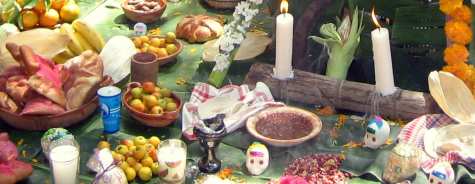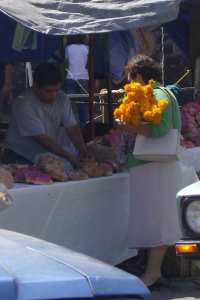Do you want to understand Mexico? Then you’ll need to learn about the DÃa de los Muertos, or the Day of the Dead. That’s why I want to tell you more about it. However, the Day(s) of the Dead is such a complex thing, I find myself at a loss to know what to say.
The holiday itself is an intersection of life, death, mockery, celebration, family, religion and culture.
For us, it was an intersection of so many of the questions and answers of why we are here – seeing and avoiding, exposing and protecting our children, knowing and not knowing when to speak and when to be silent, understanding and yet wanting to understand, wanting to speak but not being able to, fitting in and standing out. If it sounds like I’m speaking in riddles, maybe I am – last week was a riddle, and I don’t know the answer.
The celebration really goes from the 31st of October until the 2nd of November. And if you’re in Canada or the USA and you’re thinking "Hallowe’en", just forget it. I know Christians have had a lot of discussion – valid discussion – about how to be involved in Hallowe’en traditions. Hallowe’en has influenced Mexico, but the Day of the Dead celebration is something much different.
Where Canada’s Hallowe’en is mostly considered secular, the Day of the Dead is deeply religious in meaning (though with secular manifestations). The Day of the Dead is a part of national Mexican identity, so much so that the Mexican government endorses and promotes it. Foreigners are encouraged (even pressured) to be involved, because "if you want to live here you need to embrace the culture".
As far as I can tell, the Roman Catholic Church does not officially sanction Mexican Day of the Dead celebrations (though it has its own celebration – the solemn All Soul’s Day, where the living help the dead shorten their time in purgatory), but many priests do get involved in the celebrations.
This year the Roman Catholic Church here came out strong against the imported Hallowe’en traditions – claiming that "those who celebrate Halloween are worshipping a culture of death that is the product of a mix of pagan customs. The worst thing is that this celebration has been identified with neo-pagans, Satanism and occult worship."
The celebration is different wherever you go. Essentially (and you can read my previous post for a summary), the belief is that this is the time when the dead come back to visit us. Altars to the dead are set up, and offerings are placed for the dead to enjoy (such as their favourite food, alcohol, etc).

Part of an offering at our university.
Notice candy skulls, marigolds, "bread of the dead", food, and burning incense in the centre.The altars are set up in houses, stores, schools, places of business, churches – wherever. Later, many of the offerings are moved to the cemetery. Picnics and parties take place in the cemetery – family events.
These are not somber occasions, but times of colour, flowers, food, joking, candy, art, honour, and togetherness.
Our university was alive with Day of the Dead celebrations. There were altars and offerings all over the place. Students were asked to go to the market to buy offerings for the dead (and if the student declined, they were questioned strongly). At Hannah and Nathanael’s school, students were expected to bring flowers for the alter (orange marigolds). There was a potluck with parents bringing food. There were art projects, and lots of teaching about how "Mexican" it all is.
Incidentally, I won’t write all the details about what we personally decided about how our family would navigate all these traditions. That really would take a lot of writing – but feel free to ask us personally! Suffice to say we had a wild ride trying to know how to follow the Lord, show respect, learn and say what we needed to say.

Buying flowers and traditional bread
for the celebrations |
There is considerable debate about how the celebrations relate to traditional Roman Catholic and traditional indigenous beliefs in Mexico. The Aztecs set aside time to honour the dead and set up offerings for them as well. Not having a concept of Heaven and Hell, the Aztecs believed in a death "cycle", and a world of the dead that was very similar to the world of the living – and that connected with it. Some would be reincarnated, others influenced the world of the living in other ways.
Today, any concept of judgement after death is absent. Good times are remembered, bad times ignored. The world of the dead is much the same as the world of the living, and the dead visit us and interact with us much as they did when they were alive. And our actions can help to bring them "salvation".
Mexicans who feel they must reject these beliefs face dishonour in their families, rejection from their culture, uncertainty about how to honour their dead and interact with the living.
The holiday is quite possibly more important here than Christmas and Easter. Mexican traditions regarding the Day of the Dead have spread around the world. Related beliefs, such as the veneration of "Saint Death" are on the rise.
Confused? If not, you should be. Here are a few more places to look in order to better understand DÃa de los Muertos…







